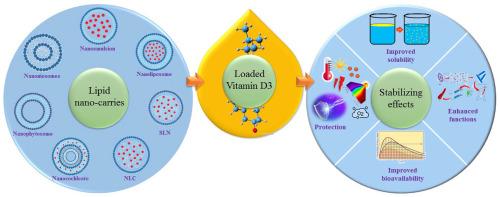Function of vitamin D3-loaded lipid-based nanocarriers in food industry: Principles, applications, and challenges
IF 15.1
1区 农林科学
Q1 FOOD SCIENCE & TECHNOLOGY
引用次数: 0
Abstract
Background
Vitamin D3 deficiency has become one of the major health concerns worldwide. More than one billion people around the globe are suffering from vitamin D3 insufficient/deficiency. Fortification a broader range of food is an effective approach to enhance the vitamin D3 intake. However, the fortification of vitamin D3 in food formula is limited due to its low solubility, poor biostability, insufficient bioavailability and un-targeted release. These drawbacks can be overcome by lipid-based nanocarriers that capable of appropriated and targeted delivery of vitamin D3 into foods.
Scope and approach
Herein, we summarized the sources of vitamin D3, its roles and requirement amounts in human body. The methods, stability, and research status of vitamin D3 in the fortification food are also introduced. In addition, various lipid-based nanocarriers and their characterization techniques for encapsulating vitamin D3 have been comprehensively discussed.
Key findings and conclusions
This review has spotlighted the different lipid-based nanocarriers, their pros and cons, and potential future applications in encapsulating vitamin D3 for food fortification. Lipid-based nanocarriers such as nanoemulsions, nanoliposomes, nanophytosomes, nanoniosomes, solid lipid nanoparticles (SLNs), and nanostructured lipid carriers (NLCs) are good candidate technologies for encapsulation of vitamin D3 with enhanced solubility, biostablity, and bioavailability. Nanocochleates, possessing lipid bilayers and clylindrical structure resembling cigars, represent a novel and promising lipid-based nanocarrier for entrapping vitamin D3. However, systematic and in-depth investigations of vitamin D3 encapsulation via nanocochleates are urgently required to explore the feasibility and mechanism of this technology.

维生素 D3 脂基纳米载体在食品工业中的功能:原理、应用和挑战
背景维生素 D3 缺乏症已成为全球关注的主要健康问题之一。全球有超过 10 亿人缺乏维生素 D3。强化更广泛的食品是提高维生素 D3 摄入量的有效方法。然而,由于维生素 D3 溶解度低、生物稳定性差、生物利用率不足和释放不定向,在食品配方中强化维生素 D3 的做法受到了限制。以脂质为基础的纳米载体能够将维生素 D3 适当地、有针对性地输送到食品中,从而克服这些缺点。还介绍了维生素 D3 在强化食品中的应用方法、稳定性和研究现状。本综述重点介绍了不同的脂质纳米载体、它们的优缺点以及未来在封装维生素 D3 用于食品营养强化方面的潜在应用。脂质纳米载体,如纳米乳液、纳米脂质体、纳米叶绿体、纳米生物体、固体脂质纳米颗粒(SLNs)和纳米结构脂质载体(NLCs),是封装维生素 D3 的理想候选技术,可提高其溶解度、生物稳定性和生物利用率。纳米螯合物具有脂质双层和类似雪茄的圆柱形结构,是一种新型的、很有前景的脂质纳米载体,可用于包裹维生素 D3。然而,迫切需要对通过纳米絮凝物封装维生素 D3 进行系统和深入的研究,以探索该技术的可行性和机理。
本文章由计算机程序翻译,如有差异,请以英文原文为准。
求助全文
约1分钟内获得全文
求助全文
来源期刊

Trends in Food Science & Technology
工程技术-食品科技
CiteScore
32.50
自引率
2.60%
发文量
322
审稿时长
37 days
期刊介绍:
Trends in Food Science & Technology is a prestigious international journal that specializes in peer-reviewed articles covering the latest advancements in technology, food science, and human nutrition. It serves as a bridge between specialized primary journals and general trade magazines, providing readable and scientifically rigorous reviews and commentaries on current research developments and their potential applications in the food industry.
Unlike traditional journals, Trends in Food Science & Technology does not publish original research papers. Instead, it focuses on critical and comprehensive reviews to offer valuable insights for professionals in the field. By bringing together cutting-edge research and industry applications, this journal plays a vital role in disseminating knowledge and facilitating advancements in the food science and technology sector.
 求助内容:
求助内容: 应助结果提醒方式:
应助结果提醒方式:


